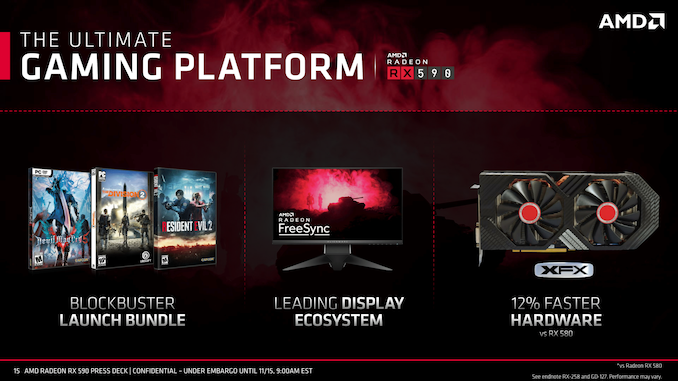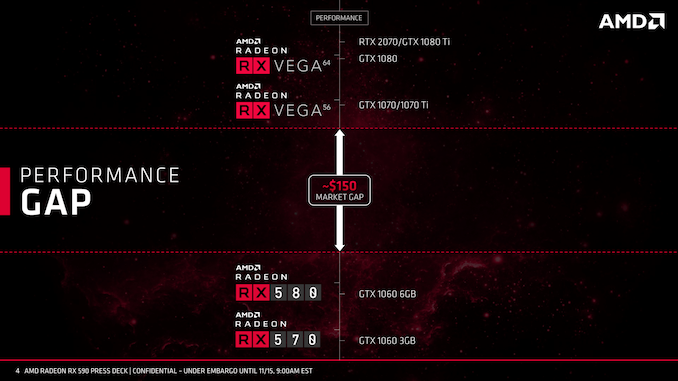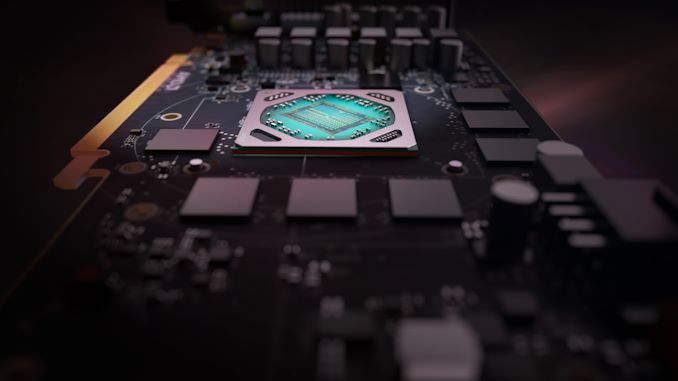The AMD Radeon RX 590 Review, feat. XFX & PowerColor: Polaris Returns (Again)
by Nate Oh on November 15, 2018 9:00 AM ESTClosing Thoughts
As we bring this to a close, the Radeon RX 590 features few, if any, surprises, indeed outperforming the RX 580 via higher clockspeeds but at the cost of additional power consumption. This is enabled by being fabbed on 12nm and being afforded higher TBPs, but in terms of overall effect, the port to 12nm is less of a die shrink and more of a new stepping; in terms of transistor count and die size Polaris 30 is identical to Polaris 10. Feature-wise, whereas the RX 500 series did introduce a new mid-power memory state, the RX 590 doesn't add anything.
Altogether, AMD is helping push the RX 590 along with a three-game launch bundle and emphasizing the value of FreeSync monitors. One might add that the RX 590 also makes the most out of the game bundle, which now presents itself as a direct value-add for the card. But the card by itself isn't providing more bang for your buck than with the RX 580.
By the numbers, then, where does the RX 590 land? Reference-to-reference, the RX 590 is about 12% faster than the RX 580 at 1080p/1440p, and 14-15% faster than the RX 480. Across the aisle, this turns out to be 9% faster than the reference GTX 1060 6GB, though the GeForce card still takes the lead in games like GTA V and Total War: Warhammer II. That matchup itself is more-or-less an indicator of how far Polaris has come - the RX 480 at launch was 11% behind the GTX 1060 6GB, and the RX 580 at launch was 7% behind. Improvements have come over the years with drivers and such, where the RX 480 and RX 580 are much closer, but the third time around, Polaris can finally claim the victory at launch.
That being said, the 9% margin is well within reach of factory-overclocked GTX 1060 6GB cards, especially with a 9Gbps option that the RX 590 doesn't have. Even with the XFX Radeon RX 590 Fatboy the delta only increases to about 11%. In other words, as custom factory-overclocked cards the RX 590 and GTX 1060 6GB are likely to trade blows. And heavily factory-overclocked RX 580s are in the similar situation.
But similar to the RX 580 and 570, the RX 590 achieves this at the cost of even more power consumption. In practical situations like in Battlefield 1, the RX 590 results in the system pulling around 110W more from the wall than with the GTX 1060 6GB. The RX 590 is not a power efficient card at the intended clocks and TBP, and so won't be suitable for SFF builds or reducing air conditioning usage.
Once again though, we've observed that VRAM is never enough. It was only a few years ago that 8GB of VRAM was considered excessive, only useful for 4K. But especially with the popularity of HD texture packs, even 6GB of framebuffer could prove limiting at 1080p with graphically demanding games. In that respect, the RX 590's 8GB keeps it covered but also brings additional horsepower over the 8GB R9 390. For memoryhogging games like Shadow of War, Wolfenstein II, or now Far Cry 5 (with HD textures), the 8GBs go a long way. Even at 1080p, GTX 980/970 performance in Wolfenstein II tanks because of the lack of framebuffer. For those looking to upgrade from 2GB or 4GB cards, both the RX 580 and RX 590 should be of interest.
So in terms of a performance gap, the custom RX 590s seem poised to fill in, though it might be in the range of 5 to 10% when comparing to existing heavily factory-overclocked RX 580s. That gap, of course, would likely have been filled by a 'Vega 11' product, which never came to fruition. Beyond a smaller discrete Vega GPU, 12nm Vega seems less likely given that 14nm+ Vega is no longer on the roadmap. And with 7nm Vega announced as Radeon Instinct MI60 and MI50 accelerators, there's no current indication of those GPUs coming into the consumer space. We also know very little about Navi other than being fabbed with TSMC on 7nm and due in 2019.
So of the possible cards in AMD’s deck, we are seeing a single 12nm Polaris SKU slotting in above the existing RX 580. If there are no further refreshes coming, then gamers will naturally ask when Polaris will be replaced as AMD's mainstream offering, as otherwise the RX 500 series will be holding the fort until then. If this is a prelude to further refreshes, then it becomes a question of how much more performance can be squeezed from Polaris.
The bigger picture is that from the consumer point-of-view, RX Vega in August 2017 was the most recent video card launch before today. There are more pressing concerns in the present: NVIDIA's recently-launched Turing-based GeForce RTX 20 series, as well as Intel's renewed ambition for discrete graphics and subsequent graphics talent leaving AMD for Intel. While the RX 590 avoids the optics of having no hardware response whatsoever in the wake of the RTX 20 cards, it is still a critical juncture with respect to DirextX Raytracing (DXR) development. And regardless, Intel has announced 2020 as the date for their modern discrete GPUs.
So as we head into 2019, it will be a crucial year for AMD and RTG. But returning to the Radeon RX 590, it applies pressure to the GTX 1060 6GB and older GTX 900 series cards, while avoiding direct pressure on existing RX 580 inventory by virtue of pricing. And right now, without anything to compete with the GTX 1080 Ti/RTX 2070 range or above, AMD is likely more than happy to take any advantage where they can. For now, though, much depends on the pricing of top-end RX 580s.













136 Comments
View All Comments
mapesdhs - Thursday, November 15, 2018 - link
Very true, though I suppose wrt the 590 this kinda works against AMD a bit since pretty much all the optimisation that the 590 could ever have benefited from is already there.sasquatch85 - Thursday, November 15, 2018 - link
I think there are quite a few owners of pitcairn-based cards that would object page 2. That GCN1 architecture made it from 78xx in 2011 up through the R7 370 in 2015. Polaris always seemed to be aiming to replace that core in the lineup and definitely fit right in at the same price levels. However, I never thought that actual performance difference was enough to justify a purchase until this 590, but that comes at a much higher price. I think I can still hold out with my 7870 for the next mid-range architecture on 7nm before finally scratching the upgrade itch.edzieba - Thursday, November 15, 2018 - link
"This is enabled by being fabbed on 12nm and being afforded higher TBPs"Traditional Buttered Pixels? Total Bungholiomark Points?
JoeyJoJo123 - Thursday, November 15, 2018 - link
Total Board Power? Because the GPU is more efficient at a 12nm process, they can spend that extra headroom overclocking the chip to run faster. That was the point of the statement.edzieba - Thursday, November 15, 2018 - link
I think it was a typo of TDP, I was just having some fun.PeachNCream - Thursday, November 15, 2018 - link
TBP is not a typo. I think it's Typical Board Power or, as Joey said, Total Board Power. AMD was swinging that term a year or three ago (not really sure when they started that) for some marketing-driven reason and, in the absence of better power and heat numbers to refer to, tech journalists are forced to resort to it in the articles they write.eastcoast_pete - Thursday, November 15, 2018 - link
@Nate: thanks for the review. Now, I know that this card (and the 1060 from Nvidia) are targeted for gaming at 1080p or 1440p with high or ultra settings, but I would have liked to see how this card does in UHD. If you have any data, please share them - Thanks! Now, I don't expect the Rx 590 or 580 to provide playable frame rates for all games in UHD, but I like to now how close these mid-rangers come to the higher-end cards when they really stressed (UHD with some goodies turned on). Plus, the extra 2 Gb of VRAM vs. the 1060 might make it possible to handle games the 6 Gb 1060 can not. Any information? Thanks!KateH - Thursday, November 15, 2018 - link
A 40CU config (as was initially rumored) would have been much more interesting- at >1500mhz boost such a card would be nipping at the heels of the GTX 1070 and at around $320 it would have been a great deal even if the TBP hit 250W but this is kind of mediocre, even if it's a bit faster than the 1060. If the price undercut the 1060 it would be a good deal but at higher price AND power? Not worth it unless Freesync is important to you. I heard some variants could clock up to 1680mhz- I'd be curious to see how that performs.Arbie - Thursday, November 15, 2018 - link
Thanks for the good article, and the inclusion of Ashes in the comparison charts.boozed - Thursday, November 15, 2018 - link
"Meh"